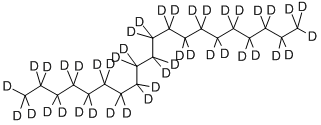N-HENEICOSANE
- CAS NO.:629-94-7
- Empirical Formula: C21H44
- Molecular Weight: 296.57
- MDL number: MFCD00009346
- EINECS: 211-118-9
- SAFETY DATA SHEET (SDS)
- Update Date: 2025-12-26 08:49:36

What is N-HENEICOSANE?
Chemical properties
white waxy solid
The Uses of N-HENEICOSANE
Heneicosane is a long chain saturated aliphatic hydrocarbon found in coal tars and fossil organic matter. Heneicosane has a high flashpoint which makes it an inefficient fuel for use in the petrochemical industry. Heneicosane is usually present in the form of paraffin wax.
Definition
ChEBI: An alkane that has 21 carbons and a straight-chain structure. It has been isolated from plants like Periploca laevigata and Carthamus tinctorius.
Synthesis Reference(s)
Tetrahedron Letters, 17, p. 2643, 1976 DOI: 10.1016/S0040-4039(00)91757-X
General Description
Crystals.
Air & Water Reactions
Insoluble in water.
Reactivity Profile
Saturated aliphatic hydrocarbons, such as N-HENEICOSANE, may be incompatible with strong oxidizing agents like nitric acid. Charring of the hydrocarbon may occur followed by ignition of unreacted hydrocarbon and other nearby combustibles. In other settings, aliphatic saturated hydrocarbons are mostly unreactive. They are not affected by aqueous solutions of acids, alkalis, most oxidizing agents, and most reducing agents. When heated sufficiently or when ignited in the presence of air, oxygen or strong oxidizing agents, they burn exothermically to produce carbon dioxide and water.
Properties of N-HENEICOSANE
| Melting point: | 39-41 °C(lit.) |
| Boiling point: | 100 °C2 mm Hg(lit.) |
| Density | 0,792 g/cm3 |
| vapor density | 10.3 (vs air) |
| vapor pressure | <1 mm Hg ( 20 °C) |
| refractive index | 1.4352 (589.3 nm 45℃) |
| Flash point: | >230 °F |
| storage temp. | Refrigerator |
| solubility | Chloroform, Hexane |
| form | Crystalline Chunks, Crystals, or Flakes |
| color | White |
| Odor | at 100.00?%. waxy |
| BRN | 1748500 |
| Stability: | Stable. Combustible. Incompatible with strong oxidizing agents. |
| CAS DataBase Reference | 629-94-7(CAS DataBase Reference) |
| EPA Substance Registry System | Heneicosane (629-94-7) |
Safety information for N-HENEICOSANE
| Signal word | Warning |
| Pictogram(s) |
 Exclamation Mark Irritant GHS07 |
| GHS Hazard Statements |
H302:Acute toxicity,oral H315:Skin corrosion/irritation H319:Serious eye damage/eye irritation H335:Specific target organ toxicity, single exposure;Respiratory tract irritation |
| Precautionary Statement Codes |
P261:Avoid breathing dust/fume/gas/mist/vapours/spray. P305+P351+P338:IF IN EYES: Rinse cautiously with water for several minutes. Remove contact lenses, if present and easy to do. Continuerinsing. |
Computed Descriptors for N-HENEICOSANE
New Products
4,4-Difluoropiperidine hydrochloride tert-butyl 9-methoxy-3-azaspiro[5.5]undecane-3-carboxylate Indole Methyl Resin N-Isopropylurea N,N-Dicyclohexylcarbodiimide(DCC) MELDRUMS ACID 5-METHYLISOXAZOLE-4-CARBOXYLIC ACID Magnessium Bis glycinate Zinc ascorbate 1-bromo-2-butyne 2-acetamidophenol 9(10H)-anthracenone Erythrosin B, 4-Piperidinopiperidine 2-((4-morpholinophenylamino) (methylthio) methylene) malononitrile 2,4-dihydroxybenzaldehyde 3-(4-morpholinophenylamino)-5-amino-1H-pyrazole-4-carbonitrile Methyl 2-methylquinoline-6-carboxylate 2,6-dichloro-4-nitropyridine 4-Bromo-2-chlorobenzonitrile 2-(benzylamino)acetic acid hydrochloride 4-(tert-Butoxycarbonylamino)but- 2-ynoic acid 3,4-dihydro-2H-benzo[b][1,4]dioxepine 1-Phenyl-1-cycloprppanecarboxylicacidRelated products of tetrahydrofuran








You may like
-
 n-Heneicosane CAS 629-94-7View Details
n-Heneicosane CAS 629-94-7View Details
629-94-7 -
![Heneicosane [Standard Material for GC] CAS 629-94-7](https://img.chemicalbook.in//Content/image/CP5.jpg) Heneicosane [Standard Material for GC] CAS 629-94-7View Details
Heneicosane [Standard Material for GC] CAS 629-94-7View Details
629-94-7 -
 N-Heneicosane 95% CAS 629-94-7View Details
N-Heneicosane 95% CAS 629-94-7View Details
629-94-7 -
 Heneicosane, 98% CAS 629-94-7View Details
Heneicosane, 98% CAS 629-94-7View Details
629-94-7 -
 Heneicosane CAS 629-94-7View Details
Heneicosane CAS 629-94-7View Details
629-94-7 -
 Heneicosane CAS 629-94-7View Details
Heneicosane CAS 629-94-7View Details
629-94-7 -
 20677-73-0 (2,2-diethoxyethyl)methylamine 98%View Details
20677-73-0 (2,2-diethoxyethyl)methylamine 98%View Details
20677-73-0 -
 3-(4-(hydroxyamino)-1-oxoisoindolin-2-yl)piperidine-2,6-dione 98%View Details
3-(4-(hydroxyamino)-1-oxoisoindolin-2-yl)piperidine-2,6-dione 98%View Details
